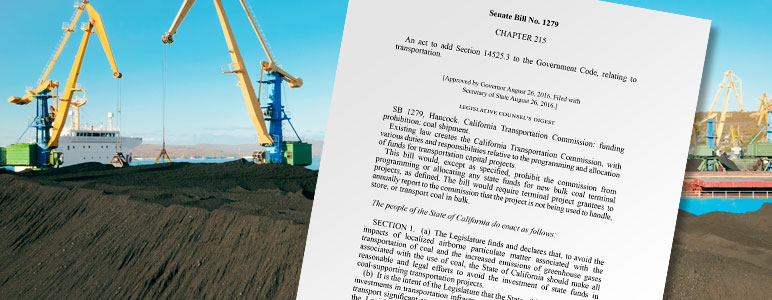


This legislative session, California further augmented policies to decarbonize all sectors of the economy and strengthen its path toward a clean energy future. Along those lines, Senator Loni Hancock (D-Berkeley) authored Senate Bill (SB) 1279 prohibiting the California Transportation Commission from providing money for any new bulk-coal terminals in the state.
The state has already drastically decreased its electricity supplied from coal plants, which now represent less than seven percent of California’s energy demand. In 2015, the state divested public pension funds from investments in coal and through legislation such as SB 350, laid out a triple-pronged approach to increase the state’s renewable portfolio standard to 50%, double statewide energy efficiency savings by 2030 and promote widespread transportation electrification.
The 2016 legislative session was no different, with California taking further monumental steps through the passage of SB 32 and Assembly Bill (AB) 197, which jointly extend the state’s Global Warming Solutions Act of 2006 (AB 32).
No coal In Oakland
SB 1279 strikes a decisive blow, prohibiting the transportation commission from programming or allocating funds for any new bulk-coal terminal project proposed after January 1, 2017. It aligns with recent actions by the Oakland City Council, which voted unanimously in opposition to coal exports through its port facilities.
Senator Hancock, along with Assembly Members Rob Bonta and Tony Thurmond and many others, showed strong leadership in opposing coal shipments from Oakland’s port, leading to the successful passage of SB 1279. Now, in the place of dirty coal, it is time to build something astonishing, focused on accelerating our clean energy future.
Next steps to clean energy
While the proposed Oakland coal terminal may have produced a handful of jobs supporting a dying industry, clean energy investments offer a better path, with higher growth potential and better overall employment offerings. The solar industry has been adding jobs at 12 times the rate of the overall economy while coal jobs are in precipitous decline. In the transportation sector, imagination, ingenuity and innovation all suggest that transformative investments and infrastructure are the keys to our economic and environmental future. In the nearby city of Vallejo, for example, officials are seeking to secure a deal to build a manufacturing facility for a growing electric vehicle company, Faraday Future.
Fundamentally, SB 1279 represents the end of an era of investment in old ways. Coal is to be replaced by investments in innovation and advancement in clean energy technology. In fact, its passage prompts us to focus on transportation and infrastructure initiatives that can support clean technology growth in Oakland, and more specifically, provides a major opportunity to support the path toward our state’s zero-emission vehicle (ZEV) goals and SB 350 Transportation Electrification objectives. Some examples include:
• Oakland’s Smart City Challenge Project: Oakland stakeholders put together a remarkable U.S. Department of Transportation proposal in support of transformative infrastructure and transportation change based on the Oakland Smart Sustainable Transportation Initiative undertaken in early 2016. These efforts serve as a testament to the city’s leadership and capability to innovate and accelerate citywide change. In fact, Oakland may find opportunity to align with recent CPUC regulatory activity focused on accelerating transportation electrification in areas complementary to their plans.
• Oakland-based Transformative Climate Communities (TCC): This year’s AB 2722 has created the TCC program, which will invest deeply in state-identified disadvantaged communities (DACs) and in support of low-to-moderate income households. Notably some of Oakland’s neighborhoods indicate high concentrations of DAC census tracts, providing the opportunity to spearhead TCC initiatives. In addition, recent Strategic Growth Council rulemaking would suggest this as a major opportunity for Oakland.
• ZEV manufacturing movement in Oakland: Consistent with many other Bay Area cities, Oakland should seek to entice ZEV manufacturing investment consistent with SB 350’s transportation electrification goals to create high-quality jobs consistent with the 2013, 2015, and 2016 ZEV Action Plans, which prioritize the expansion of these capabilities. Fundamentally, seeking investments in clean technology such as ZEV manufacturing aligns with innovation best practices and would dovetail well with state priorities focused on workforce development.

